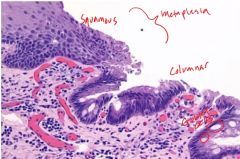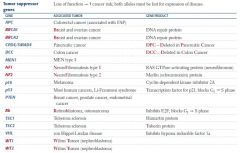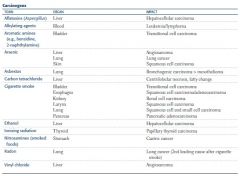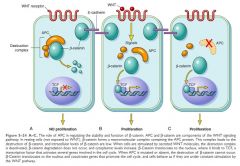![]()
![]()
![]()
Use LEFT and RIGHT arrow keys to navigate between flashcards;
Use UP and DOWN arrow keys to flip the card;
H to show hint;
A reads text to speech;
28 Cards in this Set
- Front
- Back
|
Hallmarks of cancer
|
-Evasion of apoptosis
-Growth signal self-sufficiency -Anti-growth signal insensitivity -Sustained angiogenesis (VEGF) -Limitless replication (telomerase) -Tissue invasion and metastisis (malignant) |
|
|
Carcinoma in situ/preinvasive
|
-Neoplastic cells have not invaded basement membrane
-High nuclear/cytoplasm ratio -Neoplastic cells encompass entire thickness |
|
|
Cancer invasion
|
-Downregulate e-cadherin
-Invade basement membrane using collagenases and hydrolases (metalloprotinases) |
|
|
Cancer metastasis
|
-Spread to distant organs
-Carcinomas (epithelial cancer) spread via lymphatics (breast cancer and lymphadenopathy) -Sarcomas (connective tissue cancer) spread via blood vessel |
|
|
Hyperplasia
|

-Increase in number of cells (reversible)
|
|
|
Metaplasia
|

-Change in cell type due to stress
-Columnar -> squamous (most common) -Barett's Esophagus (squamous -> columnar) |
|
|
Dysplasia
|
-Abnormal growth with loss of cellular shape, orientation and size
-Commonly pre-neoplastic -Reversible |
|
|
Anaplasia
|
-Loss of structural differentiation and function
-Irreversible |
|
|
Neoplasia
|
-Monoclonal proliferation that is uncontrolled and excessive
-Maybe be benign (-oma) or malignant (carcinoma/sarcoma) -Irreversible |
|
|
Tumor grading
|

-Determined by degree of differentiation and mitotic activity (histologically)
|
|
|
Cancer staging
|
-More prognostic value
-Tumor size -Node involvement (second most important factor) -Metastasis (most important factor) |
|
|
Types of cancer table (from First Aid)
|

|
|
|
Benign tumor characteristics
|
-Well differentiated
-Low mitotic activity -Well demarcated -Not metastasis or necrosis |
|
|
Malignant tumor characteristics
|
-May be poorly differentiated
-Erratic growth -Locally invasive/diffuse -Ability to metastasize -Decreased apoptosis |
|
|
Cachexia
|
-Side effect of chronic disease; weight loss, muscle atrophy and fatigue
|
|
|
Diseases associated with neoplasms
|
-Aids and Kaposi sarcoma
-Barrett esophagus and Esophageal adenocarcinoma -Cirrhosis and Hepatocellular carcinoma -Radiation exposure and Leukemia, thyroid cancer and angiosarcoma -Xeroderma pigmentosum and Skin cancers |
|
|
Oncogenes and cancer table (from First Aid)
|

-HER2/neu; Breast, ovarian and gastric carcinomas
-RAS; Colon cancer -bcl-2; Follicular B-cell lymphomas |
|
|
Tumor supressor table (from First Aid)
|

-APC; Colorectal cancer (associated with FAP)
-BRCA1/BRCA2; Breast and ovarian cancer -DCC; colon cancer -NF1/NF2; neurofibromatosis 1 and 2 -p53; Most cancers -RB; retinoblastoma |
|
|
Tumor markers
|
-Example PSA (prostate cancer)
-Shouldn't be used as primary tool for diagnosis, but can be used to monitor response to therapy/recurrence |
|
|
Oncogenic microbes
|
-EBV; Burkitt lymphoma, Hodgkin lymphoma and nasopharyngeal carcinoma
-HBV/HCV; Hepatocellular carcinoma -HHV-8; Kaposi sarcoma -HPV; Cervical and penile/anal carcinoma (16,18), head and neck or throat cancer -H. pylori; Gastric adenocarcinoma (rare/lethal) or MALT (Mucosa-Associated Lymphoid Tissue) lymphoma (common/benign) -HTLV-1 (Human T-cell Lymphotropic virus); Adult T-cell leukemia/lymphoma -Schistosoma haematobium; Bladder cancer (squamous cell) |
|
|
Carcinogens table (from First Aid)
|

-Aflatoxins (Aspergillus); Hepatocellular carcinoma
-Arsenic; Skin and lung (in cigarettes) cancer -Asbestos; Mesothelioma -Cigarette smoke; Lung,throat, bladder and kidney (toxins are concentrated in urine) -Ethanol; Hepatocellular carcinoma, oral/throat cancers -Vinyl chloride; Angiosarcoma |
|
|
Paraneoplastic syndromes
|
-Hypercalcemia with breast cancer
-Cushings (cortisol) with small cell lung carcinoma |
|
|
Cancer epidemiology
|
-Incidence (in order from highest to lowest)
-Male; Prostate, Lung, Colon/rectum -Femal; Breast, Lung, Colon/rectum -Mortality (again in high-low order) -Men; Lung, Prostate -Women; Lung, Breast |
|
|
Common sites of metastasis
|
-Brain; primary tumor- Lung > breast > genitourinary > bone > melanoma > GI
-Liver; primary tumor- Colon >> stomach > pancreas -Bone; primary tumor- Prostate, breast > lung > thyroid |
|
|
FAP (Familial Adenomatous Polyposis)
|
-Autosomal dominant mutation of APC gene.
-2-hit hypothesis -100% progress to colorectal cancer unless colon is resected -Thousands of polyps arise at young age; pancolonic; always involves rectum. |
|
|
Hereditary Nonpolyposis Colorectal Cancer (HNPCC/Lynch syndrome)
|
-Autosomal dominant mutation of DNA mismatch repair genes
-80% progress to colorectal cancer; proximal colon is always involved |
|
|
Molecular pathways to colorectal cancer
|

-Microsatellite instability (~15%): DNA mismatch repair gene mutation -> sporadic and HNPCC syndrome
-APC/β-catenin (chromsomal instability) (~85%) -> sporadic cancer |
|
|
APC/β-catenin/WNT and cancer
|

-Picture of the pathway
|

